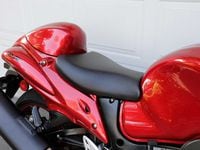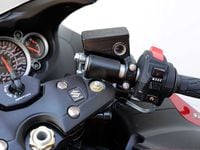Suzuki’s Hayabusa is one of the fastest production motorcycles made. But did you know it’s one of the smoothest riding too? Although it’s aged seven years in current form (find out more in the “2013 Suzuki Hayabusa ABS | First Look”), the Suzuki GSX1300R continues to impress with its swifty and regal ride.
You don’t need to swing a leg over the Hayabusa to know that it’s a big motorcycle. With a long and low strance, it’s a bike designed to appeal to larger riders. The ergonomics package is stretched out, even for a 6-foot-tall rider. Both the brake and clutch levers offer a wide range of adjustment; supersized riders with NBA player-sized hands included.
Related: 2020 Suzuki Katana First Ride Review
Swoopy, aerodynamically efficient—it does a fantastic job of shielding the rider from the elements, especially at freeway and higher speeds. On a side note, the Hayabusa gets its name and styling from the peregrine falcon, a predatory bird that can achieve speeds of up to 200 mph during a steep dive.
The windscreen offers adequate height making for a quiet and comfortable cockpit. The Hayabusa rides so well, we’re surprised Suzuki didn’t outfit it with cruise control and hard luggage, as it would make for an excellent sport-touring rig.
Obviously the Hayabusa is all about power and acceleration. Equally impressive is the level of smoothness from the 1,340cc inline-four. In spite of its age, this engine could be one of, if not the silkiest-running inline-four the Japanese brand has ever manufactured. Engine vibration is almost null and the throttle response is so well-metered, it makes more contemporary ride-by-wire systems feel crude in comparison. This makes for easy triple-digit cruising. If you had to commute on the autobahn, this would be your bike. It drinks fuel from a generous-sized 5.5-gallon fuel tank, which is another nod to its touring capability.
The engine’s good for right around 170 hp at the rear Bridgestone, and power comes on smoothly, at low rpm versus the peaky, high-revving liter-and-above-sized sportbikes of today. Despite lacking traction control, its stretched-out wheelbase and torque-rich engine dynamic make it easy to control powerslides coming out of turns. Less experienced riders will value Suzuki’s tried-and-true S-DMS which permits riders to choose from three power modes (A, B, C—A is the most power).
The suspension glides over the road and performs fabulously over bumpy pavement. It is a tad squishy in standard configuration, but fore and aft spring preload and damping adjustment allow the rider to tune the chassis to his or her liking. The OE-fitted Bridgestones feel a tad hard and outdated as compared to the latest and greatest Battlax S21 and now S22 offering. Thankfully it doesn’t take long to wear out the OE tires…
Triple-disc brakes, with fixed ABS, haul the nearly 600-pound 'Busa down from warp speed, but could offer more stopping power as compared to contemporary sportbikes. Brake feel could also be sharper.
After 21 years, Suzuki’s Hayabusa continues to impress with its bullet-like speed, head-turning styling, and high level of overall polish. Still, with dated brake hardware, absent LED lighting, and a hefty price tag considering its life span, would-be 'Busa riders will save big with a used 2013-plus machine. Regardless, the Hayabusa delivers a jet-setting magic carpet ride like few other motorcycles made.
Helmet: Shoei RF-SR
Gloves: Alpinestars Copper
Pant: Alpinestars Copper 2
Boots: Alpinestars Faster-3



















/cloudfront-us-east-1.images.arcpublishing.com/octane/IIGGWFOTOJGB7DB6DGBXCCMTDY.jpg)
/cloudfront-us-east-1.images.arcpublishing.com/octane/QSTCM6AVEZA5JJBUXNIQ3DSOF4.jpg)
/cloudfront-us-east-1.images.arcpublishing.com/octane/U4I7G625B5DMLF2DVIJDFZVV6M.jpg)
/cloudfront-us-east-1.images.arcpublishing.com/octane/B6XD6LS6IVCQPIU6HXDJSM3FHY.jpg)
/cloudfront-us-east-1.images.arcpublishing.com/octane/ICL63FEDDRDTTMINYICCEYGMDA.jpg)
/cloudfront-us-east-1.images.arcpublishing.com/octane/FCGZHQXRBZFLBAPC5SDIQLVF4I.jpg)
/cloudfront-us-east-1.images.arcpublishing.com/octane/WNOB6LDOIFFHJKPSVIWDYUGOPM.jpg)

/cloudfront-us-east-1.images.arcpublishing.com/octane/X33NU3E525ECRHXLNUJN2FTRKI.jpg)
/cloudfront-us-east-1.images.arcpublishing.com/octane/6KKT5NNL2JAVBOXMZYS5ZO76YA.jpg)
/cloudfront-us-east-1.images.arcpublishing.com/octane/J5RKG5O455GMPGQRF2OG6LRT7A.jpg)
/cloudfront-us-east-1.images.arcpublishing.com/octane/GX2CIZKQVRH2TATDM26KFG2DAE.jpg)
/cloudfront-us-east-1.images.arcpublishing.com/octane/ZWIDYSAKQZHD5BHREMQILXJCGM.jpg)
/cloudfront-us-east-1.images.arcpublishing.com/octane/CYUHJZCTSJCH3MRAQEIKXK7SCQ.jpg)
/cloudfront-us-east-1.images.arcpublishing.com/octane/LKOFINY56FCXJCANJ5M7ZDQUBY.jpg)
/cloudfront-us-east-1.images.arcpublishing.com/octane/4NBPDACMWJH63JQYJVK3QRBDZI.jpg)
/cloudfront-us-east-1.images.arcpublishing.com/octane/KKHQHRR3FJGX7H2IPU6RALMWG4.jpg)

/cloudfront-us-east-1.images.arcpublishing.com/octane/5IOFS5JAE5FOXMNA23ZRAVVYUU.jpg)
/cloudfront-us-east-1.images.arcpublishing.com/octane/CGXQ3O2VVJF7PGTYR3QICTLDLM.jpg)

/cloudfront-us-east-1.images.arcpublishing.com/octane/OQVCJOABCFC5NBEF2KIGRCV3XA.jpg)
/cloudfront-us-east-1.images.arcpublishing.com/octane/OPVQ7R4EFNCLRDPSQT4FBZCS2A.jpg)
/cloudfront-us-east-1.images.arcpublishing.com/octane/YBPFZBTAS5FJJBKOWC57QGEFDM.jpg)